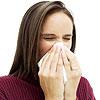When allergies attack
Allergy in Western societyEven though medical authorities are clear on the processes of allergic reaction, the progressive rise of allergies in Western society since the 60s is still a bit of a mystery. There have been several theories on why Westerners are suffering more and more from the big head, sniffly syndrome.
Down and dirty: The hygiene hypothesis
In 1989, Dr David Strachan, a British epidemiologist, suggested there may be a link between the rise of allergic disease and low levels of infection during childhood from unhygienic environments. This means children weren’t building enough immunity towards their environment, affecting them later in life.
The science behind this idea involves a process whereby white blood cells called "helper T cells" act as a type of middleman during infection, basically regulating immune response.
There are two types of helper cells: type 1 helper T cells (Th1) usually help out with bacterial and viral infections, and type 2 helper T cells (Th2) are usually reserved for parasitic type infections.
During an allergic reaction, it is the Th2 response that leads to the adverse effects. These cells are acting against naturally harmless substances (e.g. peanuts), resulting in unnecessary inflammation. Not only do Th1 and Th2 cells work differently, they also regulate each other.
During a normal Th1 response, cells will stimulate an immune response, but also suppress the Th2 cells from reacting. It has been found that newborn infants are born with a reduced Th1 response that gives rise to a dominant Th2 system.
This supports Strachan’s hygiene hypothesis. For a person to develop normal Th1, they need to have a certain level of exposure to germs. It is said that this development occurs during early childhood and is established by 5 years of age.
So what’s the rub?
In Western societies, we’re constantly soaping, cleaning, rubbing and washing to keep away nasty germs. Cleanliness was always considered to be next to Godliness, but have we gone too far?
By being overly hygienic, infants are not being exposed to the germs that lead to the natural development of the immune system.
In 2004, comparisons were made in Sweden amongst people from farming environments and those from non-farming environments. The purpose was to compare those from a natural ‘dirtier’ environment with those from city areas where there is a focus on clean and hygienic surroundings. The results supported the hygiene hypothesis, showing that those from farming environments had a lower risk of allergic disease.
Bacteria: Friend or foe?
Actually, both!
Obviously we don’t want to be shaking hands with a fluey friend, but it is well known that some bacteria are in fact useful and needed by our bodies. An example of this is the bacteria living in our stomach that we need in order to digest our food.
There is now increasing evidence that exposure to harmless bacteria that naturally live in the body is necessary for immune development too.
Scientists have done comparisons between animals that have naturally occurring gut bacteria and those that have been raised germ-free. They found those with the bacteria had better immune development, including proper Th1 and Th2 development.
Some bacteria known to stimulate the immune system properly are actually found more frequently in non-allergic children. The idea coming from these types of studies suggests that if children do not come across these bacteria, then another type of bacteria may take its place.
When Snuffleopagus strikes
The use of antibiotics at an early age may have a negative effect on the immune system, because they can very easily disrupt all kinds of bacteria in the body. While there have been studies supporting this, there are still unanswered questions as to how and why this happens.
A study in Germany showed that six or more courses of antibiotics in the first year of life were linked with a later excess of hay fever and eczema.
Using antibiotics at an early stage of life seems to have a two-pronged effect. Not only can it kill a large amount of good bacteria, but it also lowers this bacteria’s ability to stop bad bacteria growing in its place.
More research needs to be done in this field, as it may simply be a case of what is called ‘reverse causation’, meaning it is the pre-existing allergy that is causing increased antibiotic use, and not the other way around.
These are all notions, but, as we said, there are still some mysteries about the seemingly high rise in allergies.
 | For more information, see Increase of Allergies in Western Society. |
Dates
Created by:

 Login
Login














